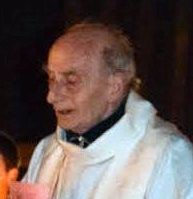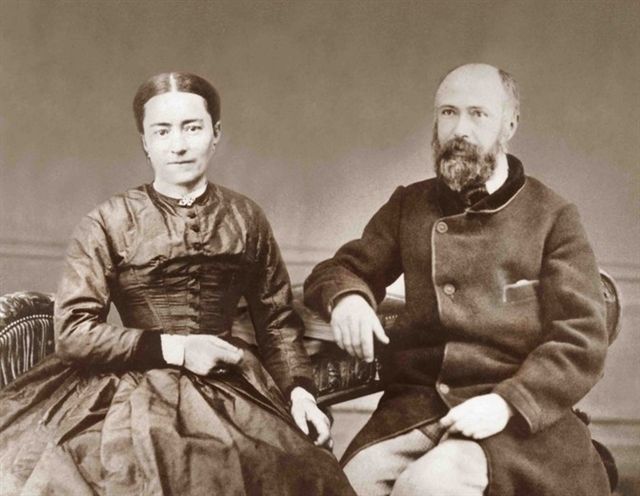"Death of a mama," on the anniversary of the death of St. Zelie Martin on August 28, 1877
/The death of a mama - August 28th, 1877
photo courtesy of the Archives of the Carmel of Lisieux.
appeared in Thérèse de Lisieux – n ° 829 – January 2003. Our thanks to the Shrine at Lisieux for permission to translate it and publish it in English
translated by Maureen O’Riordan for "Saints Louis and Zelie Martin, The Parents of St. Therese of Lisieux"
In the evening of August 26th, 1877, Louis Martin went to the Church of Our Lady to find the priest, and he himself wanted to escort the Blessed Sacrament. The whole family was assembled around the deathbed. Their hearts blended in one and the same prayer. Thérèse recorded this souvenir: "The touching ceremony of the last anointing is also deeply impressed on my mind. I can still see the spot where I was by Céline’s side. All five of us were lined up according to age, and Papa was there, too, sobbing.”1
The Sacrament was administered, and the patient’s sufferings quieted down a little. Madame Martin fell into a kind of coma. She was as though destroyed, her arms and legs swollen, unable to move her body, unable to make herself heard. It was necessary to try to interpret her thoughts by the imperceptible movement of her lips. But her eyes still spoke. When, the next day, summoned by a letter from her daughter Marie, Monsieur and Madame Guérin (Madame Martin’s brother and sister-in-law) entered her bedroom, she welcomed them with a smile, then fixed on her sister-in-law, for a long time, a deep and pleading look, as if she wanted to tell her all the hope that she put in her and her infinite gratitude.
After she had a hemorrhage, it was at the very beginning of Tuesday, August 28, 1877, at exactly thirty minutes after midnight, after a very short agony, that Madame Martin died gently. Her husband and her brother, summoned by the nursing sister, rushed into the room in time to receive her last sigh.
They immediately told the older girls, who, reassured by the nursing nun, had left the dying woman at nine o’clock in the evening. Pauline, who had taken refuge in a little room in the garden above the laundry, went in tears to the two little girls (Céline and Thérèse), but she did not want to disturb their sleep. She delayed giving them the harrowing news until the next morning.
M. Martin led Thérèse to the funeral bed. She recounts this scene herself: “Papa took me in his arms and said, ‘Come, kiss your poor little Mother for the last time.’ Without a word I placed my lips on the forehead of my dear mother.”
She seemed to sleep. Although she had reached almost the end of her forty-sixth year, she looked much younger. The face, emaciated and sculpted by suffering, had taken on, in death, a moving expression of majesty and youth. A moving atmosphere of recollection and supernatural calm enveloped the temporary mortuary. M. Martin and his daughters did not grow tired of contemplating the physiognomy of the one who, having worked so hard, at last knew rest.
As for the youngest, she gives us, in her autobiography, her testimony about these dark days. She was then four and a half years old:
I don’t recall having cried very much, neither did I speak to anyone about the feelings I experienced. . . . . I looked and listened in silence. No one had any time to pay any attention to me, and I saw many things they would have hidden from me . . . For instance, once I was standing before the lid of the coffin . . . which had been placed upright in the hall. I stopped for a long time gazing at it. Though I'd never seen one before, I understood what it was. . . . I was so little that in spite of Mama's small stature, I had to raise my head to take in its full height. It appeared large. . . . and dismal. . . . .3
The funeral in Alençon
The funeral, according to the custom of that time, took place the day after Zélie’s death, that is to say on Wednesday, August 29th, at nine o'clock, in the parish church where relatives and friends were convened. As was the custom at that time, the daughters of the deceased woman did not attend the ceremony. She was buried in the cemetery of Our Lady’s Church in Alencon.
saint Zelie Martin's first tombstone. it marked her grave in the cemetery of the church of notre dame in alencon until 1894, when her body was moved to lisieux and interred beside the body of her husband. photo credit: susan ehlert.
It was only in October, 1894, after M. Martin’s death, that M. Guérin, wishing to join in the tomb those whose common life had been a model of conjugal union, transferred the body of his sister to the family vault at Lisieux. The granite tombstone with the funeral inscription that had marked Mme. Martin’s grave at Alencon was then deposited in some free space nearby. Fifty-one years later it was recovered intact and was installed in a good location in the garden of the Pavilion (a small piece of garden with a hexagonal tower owned by the Martin family).
Praises for the memory of Madame Martin were not lacking. Without beating around the bush, the parish priest of Monsort declared that “there was one more saint in heaven.”
Mme. Guérin, who had also received her sister-in-law’s confidence and had many times profited by her experience and her delicate services, will recall her distinguished merits in a letter addressed, fourteen years later, in 1891, to her niece, who has become a Carmelite, Thérèse of the Child Jesus:
"What have I done, then, that God has surrounded me with such loving hearts! I did nothing but answer the last look of a mother whom I loved very much, very much. I believed I understood that look which nothing will be able to make me forget. It is engraved within my heart. Since that day, I have tried to replace her whom God had taken away from you, but, alas! nothing can replace a Mother! However, God has willed to bless my feeble efforts, and today He permits me to receive the affection of these young hearts. He willed that the mother who guided your early childhood be raised to a more sublime glory and enjoy heavenly delights. Ah! it is because, little Thérèse, your parents are among those we may call saints and who merit bringing forth saints.”4
The evaluation of Louise Marais, who lived for twelve years with the Martin family, is no less touching. Mme. Martin, during her illness, was forced to discharge this faithful maidservant, who was a bad influence on Léonie. Louise asked, as a favor, to continue to work for the family until the death of Mme. Martin, claiming that no one could nurse her as well as she could. Indeed, until the end she surrounded the sick woman with the most complete devotion. She moved away then, for the re-education of Léonie demanded it, but she took with her the indelible memory of the one who had shown her so much sweetness. In 1923, some months before dying, she wrote to the Carmel of Lisieux:
In my sharp suffering, I invoke my little Thérèse and, at the same time, her good and holy mother, because, if little Thérèse is a Saint, her mother, in my opinion, is also a saint and a great saint. She was very much tried during her life, and she accepted it all with resignation. And then, how she could sacrifice herself! For herself, anything was good enough, but for others, nothing was good enough. I could say a great deal to you if I told of all her goodness and her submissiveness to the will of the good God.”5
Louder than all these testimonies rises the voice of M. Martin, who never spoke of his wife without attributing to her the qualifier of “saintly;” the voice of the daughters, who, under the oath of faith, affirmed her maternal virtues in their depositions at the Process of Beatification of their little sister. Louder still speaks the youngest. Could there ever be a more beautiful portrait of a mother than this stanza written by Thérèse?
I loved Mama’s smile.
Her deep gaze seemed to say:
“Eternity overwhelms me and attracts me.
I’m going to go up in the blue Sky
To see God!”6
2 1 Story of a Soul, Ms. A, 12v.
2 Story of a Soul, Ms. A, 12v.
3 Story of a Soul, Ms. A, 12v
4 Letters of St. Thérèse of Lisieux, Volume II, 1890-1897, tr. John Clarke, O.C.D. (Washington, D.C.: ICS Publications, 1988), pp. 745-46. Note that the last sentence of the quoted passage is inauthentic.
5 quoted in Story of a Family: The Home of the Little Flower, by Stephane-Joseph Piat, O.F.M., tr. by a Benedictine of Stanbrook. New York: P. J. Kenedy & Sons, 1947., p. 260. Note that I translated this article, "Death of a mama," from an article that appeared in Therese de Lisieux, no. 829, in January 2003. It was only in 2016, searching for the source of this quotation from Louise Marais, that I realized that most of the text of this article is drawn from Story of a Family, so I want to acknowledge that book here. Note that the maidservant Louise Marais was not only a bad influence on Leonie; she beat her and alienated her from her mother. Later Leonie said “I forgive my tormentor, and I am grateful to her for looking after my mother so well during her last illness.”
6 The Poetry of Saint Thérèse of Lisieux, tr. Donald Kinney, O.C.D. (Washington, D.C.: ICS Publications, 1996), PN 18, p. 96).







